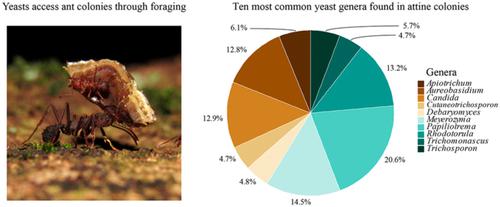Our official English website, www.x-mol.net, welcomes your feedback! (Note: you will need to create a separate account there.)
Yeasts in the attine ant–fungus mutualism: Diversity, functional roles, and putative biotechnological applications
Yeast ( IF 2.6 ) Pub Date : 2021-09-02 , DOI: 10.1002/yea.3667 Rodolfo Bizarria 1, 2 , Fernando Carlos Pagnocca 1 , Andre Rodrigues 1, 2
Yeast ( IF 2.6 ) Pub Date : 2021-09-02 , DOI: 10.1002/yea.3667 Rodolfo Bizarria 1, 2 , Fernando Carlos Pagnocca 1 , Andre Rodrigues 1, 2
Affiliation

|
Insects interact with a wide variety of yeasts, often providing a suitable substrate for their growth. Some yeast–insect interactions are tractable models for understanding the relationships between the symbionts. Attine ants are prominent insects in the Neotropics and have performed an ancient fungiculture of mutualistic basidiomycete fungi for more than 55–65 million years. Yeasts gain access to this sophisticated mutualism, prompting diversity, ecological, and biotechnological studies in this environment. We review half a century research in this field, surveying for recurrent yeast taxa and their putative ecological roles in this environment. We found that previous studies mainly covered the yeast diversity from a small fraction of attine ants, being Saccharomycetales, Tremellales, and Trichosporonales as the most frequent yeast or yeast-like orders found. Apiotrichum, Aureobasidium, Candida, Cutaneotrichosporon, Debaryomyces, Meyerozyma, Papiliotrema, Rhodotorula, Trichomonascus, and Trichosporon are the most frequent recovered genera. On the other hand, studies of yeasts’ ecological roles on attine ant–fungus mutualism only tapped the tip of the iceberg. Previous established hypotheses in the literature cover the production of lignocellulosic enzymes, chemical detoxification, and fungus garden protection. Some of these roles have parallels in biotechnological processes. In conclusion, the attine ant environment has a hidden potential for studying yeast biodiversity, ecology, and biotechnology, which has been particularly unexplored considering the vast diversity of fungus-growing ants.
中文翻译:

蚂蚁-真菌共生中的酵母菌:多样性、功能作用和推定的生物技术应用
昆虫与多种酵母相互作用,通常为它们的生长提供合适的底物。一些酵母-昆虫相互作用是理解共生体之间关系的易处理模型。Attine 蚂蚁是新热带地区的主要昆虫,并且已经进行了超过 55-6500 万年的互惠担子菌真菌的古老真菌培养。酵母获得了这种复杂的共生关系,促进了这种环境中的多样性、生态和生物技术研究。我们回顾了该领域半个世纪以来的研究,调查了反复出现的酵母类群及其在该环境中的假定生态作用。我们发现以前的研究主要涵盖了一小部分蚂蚁的酵母多样性,即酵母菌目、银耳目和毛孢菌目是发现的最常见的酵母或酵母样目。Apiotrichum , Aureobasidium , Candida , Cutaneotrichosporon , Debaryomyces , Meyerozyma , Papiliotrema , Rhodotorula , Trichomonascus , and Trichosporon是最常见的恢复属。另一方面,酵母在蚂蚁-真菌共生中的生态作用研究只是挖掘了冰山一角。文献中先前建立的假设包括木质纤维素酶的生产、化学解毒和真菌园保护。其中一些角色在生物技术过程中具有相似之处。总之,蚂蚁环境具有研究酵母生物多样性、生态学和生物技术的潜在潜力,考虑到真菌生长蚂蚁的巨大多样性,这一点尤其未被探索。
更新日期:2021-09-02
中文翻译:

蚂蚁-真菌共生中的酵母菌:多样性、功能作用和推定的生物技术应用
昆虫与多种酵母相互作用,通常为它们的生长提供合适的底物。一些酵母-昆虫相互作用是理解共生体之间关系的易处理模型。Attine 蚂蚁是新热带地区的主要昆虫,并且已经进行了超过 55-6500 万年的互惠担子菌真菌的古老真菌培养。酵母获得了这种复杂的共生关系,促进了这种环境中的多样性、生态和生物技术研究。我们回顾了该领域半个世纪以来的研究,调查了反复出现的酵母类群及其在该环境中的假定生态作用。我们发现以前的研究主要涵盖了一小部分蚂蚁的酵母多样性,即酵母菌目、银耳目和毛孢菌目是发现的最常见的酵母或酵母样目。Apiotrichum , Aureobasidium , Candida , Cutaneotrichosporon , Debaryomyces , Meyerozyma , Papiliotrema , Rhodotorula , Trichomonascus , and Trichosporon是最常见的恢复属。另一方面,酵母在蚂蚁-真菌共生中的生态作用研究只是挖掘了冰山一角。文献中先前建立的假设包括木质纤维素酶的生产、化学解毒和真菌园保护。其中一些角色在生物技术过程中具有相似之处。总之,蚂蚁环境具有研究酵母生物多样性、生态学和生物技术的潜在潜力,考虑到真菌生长蚂蚁的巨大多样性,这一点尤其未被探索。



























 京公网安备 11010802027423号
京公网安备 11010802027423号